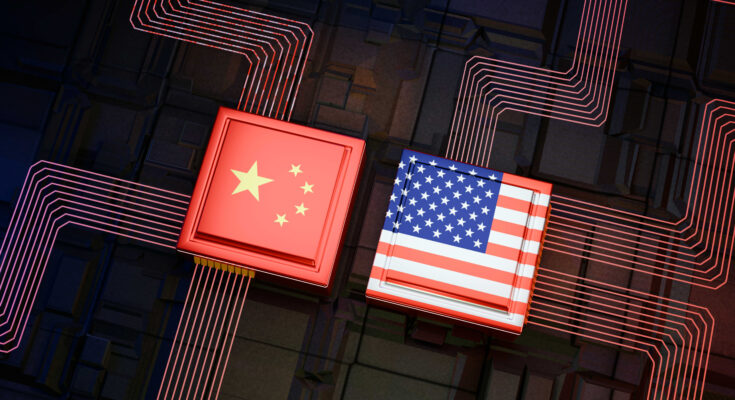The picture of the US-China war
Wong Yu Liang | A minute | Getty Images
The US has passed a series of export controls from October 2022 aimed at restricting China’s access to advanced chip technology, particularly those used in AI systems.
“China remains an important market for US chipmakers, and US restrictions on selling advanced AI chips to China are specifically designed to allow more firms of the US to continue to sell more chips to Chinese consumers,” Chris Miller, author of “Chip War.” ,” said CNBC.
Used in a wide range of products, from smartphones to electric cars, semiconductors have become a priority for governments around the world.
According to data from technology consultancy Omdia, China consumes about 50% of the world’s semiconductors as it is the largest market for consumer electronics.
US chipmakers, who enjoy a technological lead over Chinese competitors, have been able to meet this demand as US export trends have focused on highly specialized products.
William B. Bailey, a technology, media and telecommunications analyst, said: “There are still a lot of ‘high-end’ devices with all kinds of allowed cases. appropriate to the extent that US chip companies have a dominant position in Nasdaq IR Intelligence.
US chip makers, even those with major US operations, such as Micron Technology, AMD, and Nvidia, have tried to serve their Chinese customers even in the face of foreign regulation.
When the first wave of US restrictions goes into effect at the end of 2022, Nvidia and Intel created modified versions of AI products for the Chinese market.
A year later, the US revised its immigration laws to address these perceived loopholes. But, shortly after, it was reported that Nvidia is working on a new chip designed for China.
Intel is reportedly continuing to sell hundreds of millions of dollars worth of laptop processors to Chinese mobile phone company Huawei, thanks to an overseas license granted by the administration. Donald Trump.
The company did not respond to a request for comment on its plans for the Chinese market.
AMD has also developed an AI chip for China but will need to apply for an overseas license after failing to get it past US regulators last month.
The CEOs of Intel, Qualcomm and Nvidia were reportedly part of a group that planned to lobby Washington against strong chip restrictions in July last year.
The companies are also members of the Semiconductor Industry Association, the largest semiconductor trade association in the US, which released a statement at the same time calling for a reduction in tensions and an end to further sanctions due to the importance of the Chinese market for of domestic chip companies.
Amid the tough US policy situation, China has also responded in a similar way. In May last year, chips produced by the American Micron were banned from important information centers in China after failing to be inspected by the country’s Cyberspace Administration.
Micron is building a new assembly and testing facility at an existing location in Xi’an, China, as the country “remains an important market for Micron and the semiconductor industry, ” a company spokesperson told CNBC. Production is expected to begin in the second half of 2025, they said.
China has been pushing for self-reliance by building up its domestic semiconductor industry in response to countries like the US and the Netherlands limiting its access to advanced technology.
Beijing has given billions of yuan in subsidies to its chip factories in a bid to boost domestic production.
A review of Huawei’s Mate 60 Pro smartphone by TechInsights revealed an advanced chip made by Chinese chip maker, SMIC. It is said that the smartphone also has 5G connectivity – US sanctions aimed at preventing Huawei from acquiring this technology.
The Chinese government is “very focused” on getting its factories to buy chips made locally, Miller said. “Unless foreign companies have a greater technological advantage than their domestic Chinese competitors, they will lose market share in China.”
However, Phelix Lee, an equity analyst at Morningstar, said he does not expect a “change in the supply chain” as Chinese firms develop legacy chips that are ubiquitous. from household appliances to medical devices.
Legacy chips are usually mature or low-end semiconductors. US Commerce Secretary Gina Raimondo said about 60% of these shifts were made by China.
According to Brady Wang, director of Counterpoint Research, in the AI GPU market segment, American companies such as Nvidia and Intel are estimated to have three to five years of technological progress in than Chinese competitors.
“We believe that China can still build its domestic GPU supply chain for certain market segments, but the revenue will be lower, and the cost will be much higher,” he added. .
#China #remains #important #chipmakers #escalating #tensions #worlds #largest #economies
